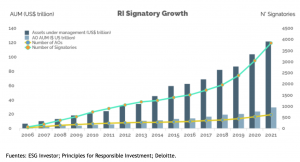
2021 was the year of the zero net emissions commitment. We saw it at COP 26, where countries, companies and investors lined up to establish plans to decarbonize economies and put the focus on nature and, therefore, on humanity and the path to living sustainably within planetary limits.
To achieve near-term goals, action must be taken quickly. Last November, the Glasgow Finance Alliance for Net Zero (GFANZ) committed USD 130 trillion of private capital to reducing greenhouse gas emissions through more than 450 firms from 45 countries over the next 3 decades.
The accelerated allocation of private capital to sustainable investments at scale is based on actionable information on both risk and environmental impacts, opening up the debate of so-called dual materiality, where a company's inward (financial) impact should be given equal prominence to its outward (environmental, economic and human) impact. Faith Ward, chair of the Institutional Investors Group on Climate Change (IIGCC) and head of Responsible Investment at the £35 billion Brunel Pension Partnership, is clear: "Incorporating dual materiality is essential for responsible investment and climate mainstreaming to adapt to the 21st century. Looking at only half of the equation seems very old-fashioned."
To date, Europe has made the boldest commitment to dual materiality, which is explicitly included in the Corporate Sustainability Reporting Directive (CSRD) and its underlying European Sustainable Reporting Standards. In Chile, we have a significant challenge and commitment in the incorporation of ESG parameters, with public investment plans for an additional US$ 4.5 billion over the regular budget from August 2020 to 2022, sovereign green bonds for USD 7.6 billion issued to date, similar to the amount of green bonds issued by the private sector.
At Fynsa we are committed to integrating these parameters through our investment funds: Rockville Solar Energy FundThe Rockville Solar Energy Fund, avoids the emission of 144 thousand tons of CO2, equivalent to 1.8 million trees for a period of 10 years. Fynsa Migrante FundThe Fynsa Migrante Fund, which generates positive externalities in terms of the social integration of immigrants seeking access to credit, whose portfolio at the end of December totaled more than $16 billion. Fynsa Energy Fund The Fynsa Energy Fund reduces 78,300 tons of CO2 per year and supplies clean energy to more than 90,000 homes. These and other challenges are part of what is coming for 2022 in terms of impact investment.

AGF Team